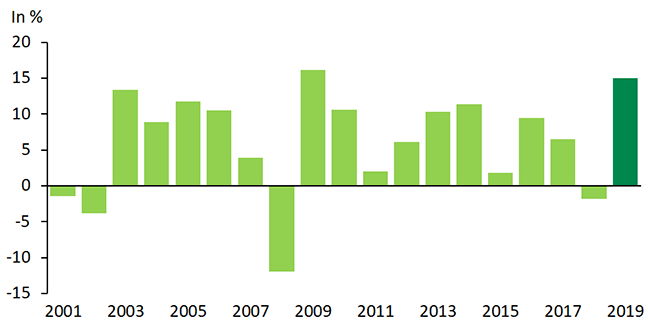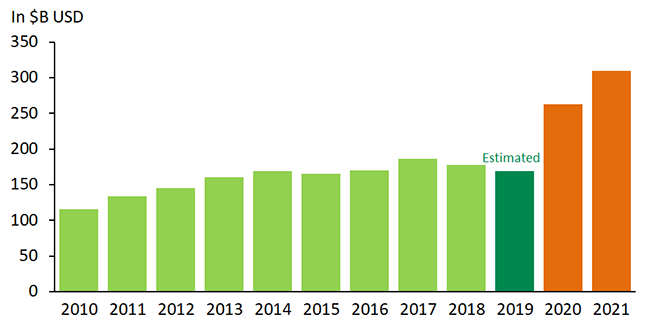Global economy and financial markets - What to watch for in 2020
Last year we saw a slowdown in global growth (graph 1), affected in no small part by protectionist measures taken by China and the US.
Graph 1 – Slower global economic growth

The escalation between the countries hit international indexes and the manufacturing sector hard. The overall sense of uncertainty also negatively affected business investment. Despite the gloomy economic environment, several central banks, including the US Federal Reserve and the European Central Bank, took steps to loosen their monetary policy again. Advanced countries followed suit by making significant cuts to key rates. The moves not only propped up consumer spending and housing, but also buoyed performance in financial markets. Despite a relatively tough political and economic environment last year, 2019 turned out to be very positive for investors (graph 2).
Graph 2 – Despite global headwinds, 2019 was very positive for investors

Last year finished on an encouraging note, as the UK Conservatives won a convincing majority in Parliament and China and the US reach a “phase one” trade deal. The news put to rest, at least for now, the worst-case scenarios for Brexit and the trade war. Canada, the US and Mexico also cleared the final hurdle for the new Canada-United States-Mexico Agreement. Fears of a global recession, which had peaked at the end of the summer, seemed to have completely disappeared when the calendar turned over to 2020.
But the sense of economic optimism is being tempered by the coronavirus epidemic in China. The country has taken draconian measures to try and check the spread of the virus, but the response has had a major impact on their economy. As we go to press, it’s impossible to predict how the epidemic will evolve and if it will have lasting consequences for the global economy, and especially the North American one. What we do know is that widespread transmission of the virus presents a real risk for businesses exposed to Asian markets. We need to follow the situation closely. But looking back at similar cases (take SARS for example, which caused some worry in early 2003), the effects of these types of events on the global economy and financial markets are often short term.
There are several other elements beyond the ripple effects of the virus that could affect the economy and financial markets. First among them is the evolution of the relationship between Beijing and Washington, which will continue to be closely watched. The agreement reached in December was essentially a truce, but most of the tariffs the US put on Chinese goods remain in place. The next stages of negotiation look to be very complex and could cause more friction over the next few quarters. The promise from Chinese authorities to significantly boost their purchase of US goods (graph 3) could end up being a sticking point, and we’ll have to keep on eye on US willingness to show some flexibility in the current environment. Geopolitical considerations—the ongoing political crisis in Hong Kong and the recent re-election of an independent-leaning government in Taiwan among them—could put stress on the relationship between the two superpowers.
Graph 3 – China agreed to an ambitious increase in imports of US goods following the trade deal in December

We’ll also be watching the political environment in the US in the leadup to the 2020 presidential election in November. The financial and economic repercussions of a Trump-Biden contest in the general would probably be limited. But the story could be different if a candidate from the Democrat’s progressive wing wins the primary, or the presidency. Entrepreneurs who have already been burned by the trade war and have been hit by fallout from the coronavirus would probably see that outcome as another reason to be cautious with their investments. And the unpredictability of President Trump will probably result in a few surprises, especially if he’s re-elected. The spike in tensions with Iran at the beginning of 2020 is a good example.
What should investors expect?
The coronavirus outbreak aside, North American stock market indexes started this year off strong. But we’ll be quite surprised if the main indexes repeat the incredible year they had in 2019. The remarkable gains last year are partly due to the big dip in the markets at the end of 2018, when fears of a recession were ramping up. The current environment is very different than it was one year ago. The outlook for global economic growth is positive but tempered. And the existence of a number of geopolitical issues leads us to anticipate more conventional returns for North American stock market indexes this year, on the order of 7–8%, including dividends. More stable bond rates could limit bond yields, as well. We think investors can expect good results but shouldn’t expect a repeat of 2019. The increased levels of volatility we’ve seen since the beginning of the year could be here to stay, at least in the near term.
